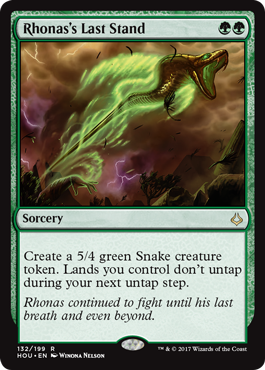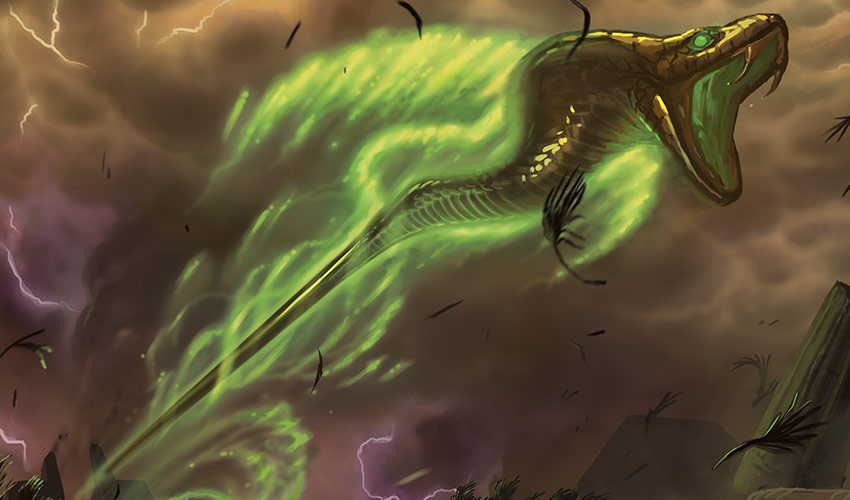Rhonas's Last Stand
It is now the Hour of Devastation.
It's finally here. Months and months ago, when Amonkhet was announced, Hour of Devastation was uttered in the same breath. We all knew that Amonkhet would be in some kind of trouble. And indeed, Nicol Bolas isn't letting us down.
Amonkhet's supposed savior has turned wrathful. In addition to the Gatewatch's best efforts, many of the denizens of the plane are trying to fight back against him to avoid utter ruin.
And it's more than just the mere mortals chipping in to try and take down Bolas.
Let me back up for a second.
In Amonkhet, you saw the exert mechanic. This mechanic appeared on creatures, letting you prevent them from untapping for a turn when they attack so you could receive a bonus effect.
Now, exert is back in Hour of Devastation as well—and with a couple new twists we didn't do in Amonkhet. Your array of Humans and Minotaurs and so on can exert in some similar (and some new) ways. For example, we've added exert into the costs of some tap abilities, so if your creature works really hard, they can make extraordinary things happen.

So that's all fine and good. But that's not where it ends.
What happens when a God exerts itself? Or, more to the point, when you harness the power of a God exerting itself?
Any guesses?
There's a cycle of five cards in Hour of Devastation that do just that. And today, I'm going to show off the green member of that cycle. Behold: Rhonas's Last Stand!

These are five monocolored sorceries, one for each of the five Gods you saw in Amonkhet. They all do something awesome and prevent your lands from untapping during the next untap step.
Or, in short: they exert you.
They're all pretty wild—as you can tell with Rhonas's Last Stand here. Two mana for a 5/4? That's absurd! There's just this little drawback on it.
And, as is the case with all Magic drawbacks, I begin to wonder if it's worth it on its own . . . and what ways I can exploit it to make it not as painful. So considering these are five marquee cards from the set, let's spend today talking about a few ways to build and play with these "self-exert" cards!
- Casting on Curve
The first question you have to ask yourself is this: on its own, in my deck, is this drawback acceptable for this effect if I play it on curve? (In this case, turn two.)
With Rhonas's Last Stand, you can slam it on turn two, and be ready to attack with a 5/4 next turn. Now, if you're an aggressive green deck, that might just be okay on its own: you're willing to take a turn off to attack in for 5 damage a turn before you would otherwise.
But that doesn't come without risks. A single removal spell or bounce effect could be disastrous, undoing your turn and swinging the tempo in favor of your opponent.
Alternatively, there are some matchups where you should feel fairly safe about putting this out right on turn two. For example, against a red deck, they likely will have to spend two burn spells to kill it off—in which case, you're getting the upper hand.
Trying to think about what your opponent may or may not have access to is crucial to knowing if you should cast this card on time, or wait for another opportunity. How badly can your opponent punish you if you take a turn off for a very strong effect? That depends on the opponent.
The other key element in this specific instance: what does your turn three look like? If your turn-three play is weak or non-existent, then it's a great time to make a Last Stand. If you have a great turn-three play, on the other hand, then you may want to hold off.
- Casting Off Curve
Where these cards tend to get really interesting is when you play them off curve.
It's easy to see a mana cost and think, "On this turn, I should try and play that card as soon as possible." But, as we talked about last week, it's not always right to play a card just because you can.
For example, let's say you've built an aggressive green deck, or perhaps something like the midrange black-green decks you see in Standard. You have enough other early drops that you play one of them instead of Rhonas's Last Stand on turn two. And then, come turn five, you tap two lands and fire off the powerful self-exert spell.

This gives you a couple options.
For one, it means you can leave three mana open for the next turn. If you draw something you can cast, it leaves you the opportunity to put it down.
Alternatively, you can use that other mana to cast another spell, applying additional pressure to your opponent without forcing yourself to skip turn three (which can be a pretty fundamental turn for an aggressive deck). Skipping your untap step on turn six can be okay, given that you already have a board presence and likely won't be wrecked by a single removal spell on your 5/4 token.
And, of course, casting it late gives you another potential advantage . . .
- Wait Until You're Out of Action
You're going to use your lands to cast your spells . . . But if you have no more spells to cast, then all you're competing with is the card on top of your library!
Let's say you empty your hand of threats by turn four, and just have lands left in your hand. Well, that's a pretty good time to cast Rhonas's Last Stand! You could certainly draw something you want to cast and can't, but, with most decks, odds are you'll be able to play it with the lands you'll have left, or taking the turn off from casting it was worth getting your 5/4.
On the flip side, this can be the lowest impact time to cast the spell, at least in the case of this one. A 5/4 on turn two is a lot more impressive than a 5/4 on turn four. So you'll have to weigh the right play depending on the situation.
- Break the Drawback
And finally we come to my favorite part of any card with a drawback: how can we break this drawback to circumvent it entirely?
One way to get around your lands not untapping is to use lots of additional mana sources that aren't lands—which, conveniently for this example, also appear in green. So, for example, playing with mana rocks like Cultivator's Caravan or creatures that make mana or untap lands like Llanowar Elves, Voyaging Satyr, and Hope Ten—err, ignore that one. You'll see it later in the preview season.
Anyway, that's certainly one way to help break the drawback. But there's another big way to beat the drawback on these.
Often with effects like these, you skip your next untap step. (For example, Savor the Moment.) This means if you cast two Savor the Moments in a turn, you'll skip your next two untap steps.
However, that's not the case here!
This cycle simply says lands you control don't untap during your next untap step—the untap step still happens!
Are you thinking what I'm thinking?
. . . Err, no. That's not quite right. But, uh, that's good to know about you.
What I was going to say, though, is that you can cast two (or more!) of these spells and just skip one round of your lands untapping.
So let's say it's turn four, you have four forests, and two of these in your hand. Well, you can make two 5/4s and only lose one untap step! Now that's a way around it.
Now you just need to find out what the other cards in this cycle do so you can put them all together in the same deck! You'll just have to hold on a bit longer and see what they are (except for one).
Taking a Stand
So, what's the best way to play these cards? The most important part is to know all the different things you can do with them and make the right decision in the moment!
I wouldn't go into a match planning to definitely play Rhonas's Last Stand on turn two or definitely planning to wait until later. On turn two, you need to evaluate the board, your hand, your opponent, and make the best decision at the time. Sometimes, you'll take a deep breath and cast it, and other times you'll hold off. Either decision can be the right play.
Hopefully now you find yourself a bit more well-armed to make that decision.
Have any questions or thoughts on anything here today? Let me know! It's always great to hear from you. You can send me a tweet, ask me a question on my Tumblr, or send me an e-mail (in English, please) at BeyondBasicsMagic@Gmail.com
I'll be back next week with something that truly says Hour of Devastation. In the meantime, enjoy the rest of previews . . . and plotting how you're going to use these cards to cause the downfall of your enemies, Nicol Bolas–style.
Talk with you soon,

